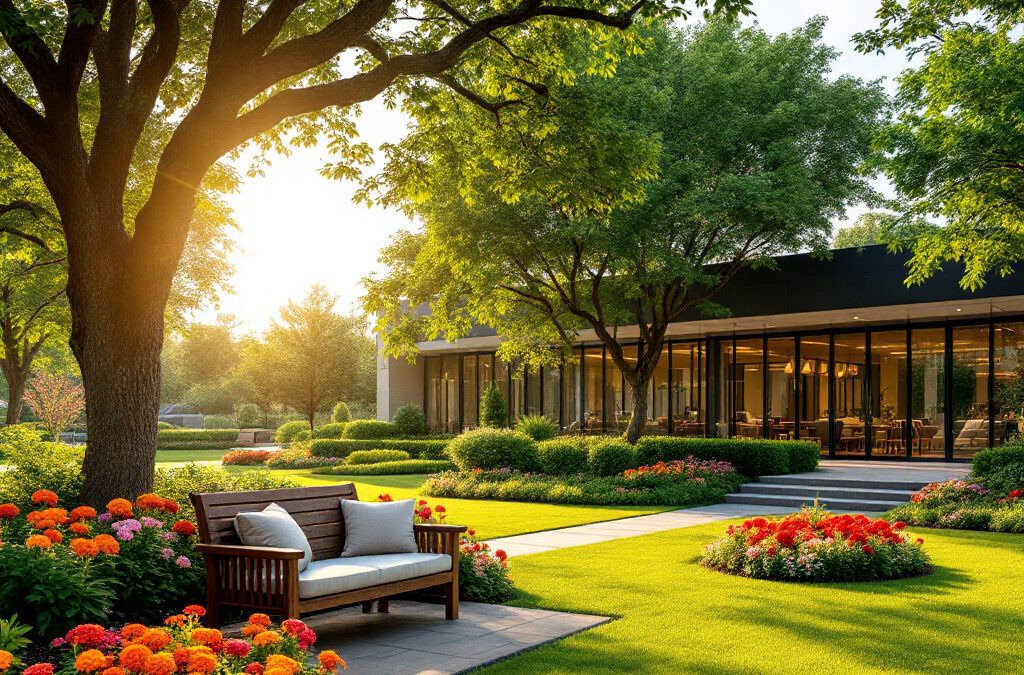I. Introduction
Landscaping is a crucial element of commercial properties that significantly impacts their market value. Well-designed outdoor spaces not only enhance the overall appearance of a property but also contribute to its functionality and environmental sustainability. Understanding how landscaping influences property value is essential for property owners looking to boost their investments.
II. The Aesthetic Appeal of Landscaping
A. First Impressions and Curb Appeal
Curb appeal is often the first opportunity for businesses to make a lasting impression on potential clients and customers. Professionally landscaped surroundings create an inviting atmosphere that can attract foot traffic and encourage inquiries. A visually appealing landscape can set a positive tone for a business, suggesting professionalism and care.
B. Examples of Visually Appealing Landscapes
Consider the impact of features like vibrant flower beds, manicured lawns, and thoughtful arrangements of trees and shrubs. Properties that showcase a balance of color, texture, and seasonal interest tend to stand out in the competitive commercial market. For instance, a retail storefront with welcoming landscaping can make a significant difference in customer engagement and footfall.
C. Psychological Impact of Attractive Outdoor Spaces
The psychological benefits of attractive landscapes cannot be overstated. Research indicates that beautiful outdoor environments can enhance mood and wellbeing, which may influence customers’ experiences. An inviting landscape not only benefits visitors but can also foster a productive environment for employees.
III. Enhancing Functionality
A. Usability of Outdoor Spaces for Businesses
Functional outdoor spaces are essential for maximizing the use of commercial properties. By designing areas that encourage social interaction or relaxation, businesses can enhance their overall appeal. This usability translates into improved customer satisfaction and employee morale.
B. Incorporating Areas for Relaxation and Gatherings
Creating dedicated areas for relaxation or informal gatherings can stimulate social interactions among customers and staff. Patios, benches, and shaded areas not only provide comfort but also encourage longer visits and repeat business. A well-thought-out outdoor space can serve as an extension of a business’s interior, enriching the customer experience.
C. Spaces for Outdoor Dining or Customer Engagement
For commercial properties such as restaurants or cafes, landscaped areas suitable for outdoor dining can be a major selling point. These spaces can attract more customers looking for pleasant and engaging dining experiences. Additionally, they help to foster a sense of community which can be invaluable for brand loyalty.
IV. Environmental Benefits
A. Impact on Local Ecosystems
Landscaping plays a key role in supporting local ecosystems. Well-planned green spaces can attract pollinators, birds, and beneficial insects, enhancing biodiversity. This, in turn, can enhance the overall health of the environment surrounding commercial properties.
B. Role of Landscaping in Reducing Urban Heat
Landscapes contribute to the mitigation of the urban heat island effect. Trees and plants provide shade, cooling the areas around buildings and reducing the need for air conditioning. This can lead to lower energy costs, making properties more appealing to potential businesses and tenants.
C. Contribution to Stormwater Management
Effective landscaping can help manage stormwater runoff, reducing the risk of flooding and erosion. Green roofs, rain gardens, and permeable pavement are examples of sustainable practices that require careful planning and maintenance. Implementing such features can enhance a property’s appeal while supporting ecological health.
V. Economic Factors
A. Return on Investment (ROI) for Landscaping
Investing in quality landscaping can yield a substantial return. Studies suggest that a well-maintained landscape can increase property value by up to 20%. This ROI demonstrates that improving the grounds of commercial properties is not just an aesthetic decision but a smart financial strategy.
B. Energy Efficiency Through Strategic Planting
Strategically placed trees and shrubs can increase a building’s energy efficiency by providing shade and reducing heating needs. This not only contributes to a lower carbon footprint but can also save property owners money in utility expenses. The long-term savings and increased value make landscaping an essential element of property management.
C. Comparison of Costs vs. Property Value Increase
While upfront costs for landscaping can vary significantly, the increase in property value often outweighs these expenses. Property owners should carefully weigh the investment against the potential benefits to accurately forecast long-term gains. A well-planned landscape is an investment in both aesthetic appeal and economic growth.
VI. Maintenance Considerations
A. Importance of Regular Upkeep
Maintaining landscaped areas is crucial for preserving property value. Regular upkeep ensures that plants remain healthy and the landscaping looks professional and inviting. Neglecting these areas can lead to deterioration, which can diminish the overall value of a property.
B. Costs Associated with Maintenance
Property owners must consider the financial implications of maintaining landscaping. While ongoing care requires investment, the stability and enhancements to property value often justify these expenses. Implementing efficient maintenance schedules can minimize costs while maximizing visual appeal.
C. Impact of Neglect on Property Value
Neglected landscapes can lead to adverse perceptions and a direct decline in property value. Overgrown plants and unkempt grounds can not only repel customers but also signal a lack of professionalism. The failure to properly maintain landscaping can result in diminished property appreciation.
VII. Case Studies
A. Successful Commercial Properties with Quality Landscaping
Several commercial properties have thrived due to thoughtful landscaping. For example, retail centers that incorporated green spaces and seating have seen increased foot traffic and higher sales. This demonstrates the tangible benefits that quality landscaping can provide.
B. Data on Property Value Appreciation Linked to Landscaping
Research indicates that properties with well-designed landscapes appreciate at a higher rate compared to those without. Studies conducted across various regions reinforce the notion that attractive greenery not only appeals to buyers but also affects overall market trends positively.
C. Lessons Learned from Poorly Landscaped Properties
In contrast, properties with poorly executed landscaping have faced challenges related to tenant retention and reduced customer engagement. Learning from these examples, property owners can prioritize landscaping to avoid unnecessary financial pitfalls.
VIII. Choosing the Right Landscaping Strategy
A. Factors to Consider (Location, Climate, Business Type)
Tailoring a landscaping strategy requires consideration of various factors such as location and climate, and the nature of the business. Different environments necessitate different types of vegetation and design principles. A thorough understanding of these elements can lead to more effective and sustainable landscaping solutions.
B. Hiring Professional Landscapers vs. DIY
Deciding between professional landscaping services and a do-it-yourself approach is crucial. While DIY can save money, professionals can provide valuable expertise and design insights that enhance property value. Weighing these options can help property owners make well-informed decisions. For related insights, check out this guide to profitable commercial bidding.
C. Sustainable Landscaping Options
Sustainable landscaping options have gained popularity due to their environmental benefits. Incorporating native plants, xeriscaping, and organic maintenance practices can contribute positively to both the ecosystem and the property’s profile. Such approaches appeal to eco-conscious businesses and customers alike. Learn more about eco-friendly planning in our Pre-Pour Checklist for Large Commercial Jobs.
IX. Conclusion
In summary, the relationship between landscaping and property value in commercial real estate is significant and multifaceted. Investing in quality landscaping is a strategic decision that delivers measurable benefits across aesthetic, functional, environmental, and economic dimensions. From creating a powerful first impression to enhancing usability, promoting sustainability, and increasing property value, landscaping plays a vital role in the long-term success of commercial properties.
However, realizing these benefits requires thoughtful planning, regular maintenance, and alignment with the specific goals of the business and the unique characteristics of the property. Whether it’s through vibrant plantings, functional outdoor areas, or sustainable design features, professional landscaping can transform a property into a valuable asset.
CALL US NOW TO GET A QUOTE and discover how expert landscaping can elevate your commercial property’s appeal, performance, and profitability.


